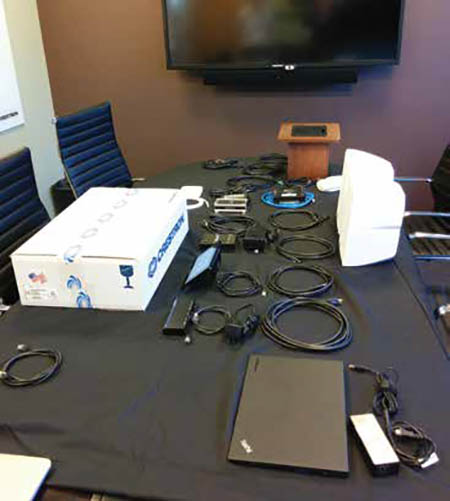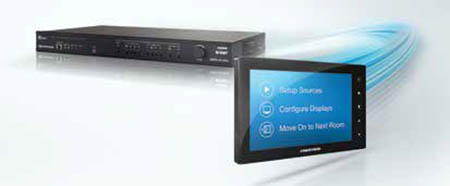Looking for a high-performance video switcher but don’t have the time to become a programmer or the money to hire one? Crestron’s latest DigitalMedia Presentation System can not only put all the pixels in the right places without a line of code in sight, but points the way to the future of video distribution.
The secret of the DMPS3-4K-150-C is that Crestron’s clever programmers have hidden all the programming code beneath an interface that even a child could figure out. Regardless of whether you want to change sources, tweak the audio or resize a screen, it’s all in your face.
NETWORK CENTRIC
More than a mere switcher, the DMPS3-4K-150-C has a 4K scaler, audio mixer and digital signal processor. Fully IP-based, it can use IP versions 4 and 6 and tops out at an ultra-HD resolution of 4,096 by 2,160. By contrast, Crestron’s older and less expensive DMPS-100-C switching system maxed out at 2,048 by 1,152 resolution, with support for up to eight sources. The DMPS3-4K-150-C can handle 10 inputs and one output.
Either way, the system allows the right video to be put on screen, regardless of whether it’s in a classroom, boardroom or auditorium. Inside the DMPS3-4K-150-C is a quad-core 1GHz processor as well as a dedicated graphics engine that can put pixels in their place. There’s a gigabyte of SDRAM and 4GB of flash storage for holding its software and commands. The system uses the Windows Embedded operating system and has the potential to move around up to 72Gbps of video data.
The DMPS3-4K-150-C’s connection potential is prodigious with its ports arranged by type rather than input number as was the case with the DMPS-100-C. In addition to four HDMI and four VGA inputs (with matching audio inputs) the system has a pair of HDBaseT digital video inputs, one output for HDBaseT digital video and an Ethernet networking connection. There’s also an HDMI output port to mirror the visuals, such as on a lecture hall’s lectern.
There are two relay ports to control something such as an electrically-powered screen, an RS-232 serial port and four USB slots in the back that work with the company’s Connect It accessories. There’s even an infrared port for controlling things like a Blu-ray player.
Front and center, is the DMPS3-4K-150-C’s master volume knob, but the switcher lacks the monochrome status screen of the DMPS-100-C. It also removes several little-used ports, like SPDIF optical audio and Y-Pb-Pr video plugs, but you can use adapters to integrate these items.
The trade is worth it because the all-black 150-C takes up a single rack position as opposed to the triple height DMPS-100-C, effectively eliminating two-thirds of its bulk. At 6.4-pounds, it’s easy to handle and fits into a standard AV rack and comes with hardware for mounting it under a table. Its power supply is on the inside, so there’s no pesky AC adapter to hide.
Based on Crestron’s DM 8G+ protocol, you can send the audio and video anywhere in your organization and the entire AV landscape can be monitored by a Crestron Fusion server with minimal setup. It can link with Crestron AirMedia for connecting computers, tablets and phones, but the system can’t connect via Miracast, WiDi or Apple’s AirPlay. With the proliferation of wireless-only tablets, this will become more and more important.
The 4K scaling circuit can set up independent output specs for each display so that the material can be viewed in its native resolution. It can not only turn 2,560 by 1,440 input into beautiful 4K material, but it can downconvert it for an HD screen as well. This can cut out the delay that you often see when a screen needs to adjust its parameters.
While earlier Crestron equipment used the company’s Toolbox software for configuration, the 150-C has a built-in Web server that delivers set-up screens to any connected computer. This means that not only is there no software to load on the computer you use for configuring the system, but the program is updated along with the firmware.
The 150-C’s interface is bright, functional and visually oriented. There are large areas to click- or tap-on to Crestron’s DMPS3-4K-150-C make changes or see details. The gamut of choices is out in the open with easy to read fonts and includes everything from routing and audio equalization settings to the aspect ratio and resolution of the screen.
CABLE CHECK

When you’re done setting up the DMPS3-4K- 150-C, these configurations can be saved to the computer for later recall, making it easy to set up a fleet of DMPS3-4K-150-C switchers with the same configuration. You can also check the cable integrity for each device, a helpful feature when troubleshooting a problem or testing the gear before an event.
During this test drive, we put together two setups with the DMPS3-4K-150-C that show its range and depth. First, in about 10 minutes, we set up two laptops and a HDMI-connected HD TV. For simple set ups, like this, the system requires little or no intervention other than opening the box and plugging the devices in, because the system uses the HDMI CEC standard to control the display.
The DMPS3-4K-150-C switcher comes into its own when it’s connected to Crestron’s $1,600 TSW-752-B touch screen, allowing you to control everything from a wall or desktop. At this point, just about anyone can quickly switch among inputs.
This came in handy when we installed a 150-C with a couple of laptops, audio, wireless connections, the touchscreen controller and a network-connected ultra HD TV; this took about 20 minutes. After turning the TSW-752-B screen on, the touch screen found the DMPS3-4K-150-C on the first try using the last 8 characters of its MAC address, which is printed on the back of the unit. Then, we named each input and output item and gave them icons, although using the screen’s touch keyboard slowed things down.
Once we got the right playback software together on a connected laptop, 3,460 by 2,160 resolution clips looked nothing short of spectacular. The stream was not only sharp and rich, but the sound synchronization was excellent.
The system’s switching is nearly instantaneous when bringing up a new source and the built-in scaler lets you control the video’s overscan and zooming. You can even stretch it to fit the screen at hand, which can come in handy if you have a mix of 16-by-9, 16-by-10, and 4-by-3 screens.
TAG TEAM

If the DMPS3-4K-150-C will be used for business meetings or college seminars where participants will need to quickly connect and disconnect with the screen, Crestron’s software can embed a simple.xml file into an Outlook invitation or email that contains all the connection info needed. Just click on it and a few seconds later you’re on-screen via the AirMedia connection.
A big bonus is that the DMPS3-4K-150-C provides Power over DigitalMedia so that modules, like the company’s HDBaseT-to-HDMI room box do not require their own power plugs. Similarly, the TSW touch screen is powered over Ethernet. This not only simplifies set up but can make for a neater installation. All told, the DMPS3-4K-150-C consumes about 50 watts at peak use, making it applicable for portable use, like in an engineering trailer or mobile home.
The DMPS3-4K-150-C is so far ahead of its time that it is in a class by itself. There’s live 4K video gear from companies like Blackmagic, but they neither have analog video inputs nor support things like HDMI-CEC.
In a world that is still getting comfortable with HD video, the DMPS3-4K-150-C runs the risk of being overkill for many installations. On the other hand, the switcher renders most other video switching gear obsolete overnight and provides a sneak peek at the future of video distribution.
Brian Nadel is a regular contributor to AV Technology Magazine.
Key Specs of Crestron’s DMPS-3-4K-150-C
PRICE: $5,000PROS:
- Up to 4K resolution
- Built-in up- and down-scaling
- Low power use
- No programming needed
- Touch screen option
- Simple set-up screens
CONS:
• One display output (mirrored to both HDBaseT and HDMI)
• No direct wireless connections
ONLINE RESOURCE :
